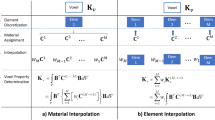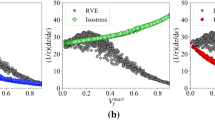Abstract
This work presents a description of the Batch Reification/Fusion Optimization Framework (BAREFOOT). BAREFOOT is a Bayesian Optimization (BO) Framework that has been built specifically for the aim of material optimization and design. The Framework combines multi-fidelity model fusion with batch BO to enable accelerated materials design. The Framework is built in Python and is available as open-source code. The Framework offers the capability to do pure Batch BO, pure Multi-Fidelity (sequential BO), or combine both methods. Since BO relies on acquisition functions, we have implemented many of the most commonly used acquisition functions in the Framework. Finally, the Framework is capable of both single- and multi-objective optimization approaches. This work presents an overview of the Framework and the calculation methods available and demonstrates the Framework’s performance based on generic optimization test functions.













Similar content being viewed by others

References
Allison J, Backman D, Christodoulou L (2006) Integrated computational materials engineering: a new paradigm for the global materials profession. JOM 58(11):25–27
McDowell DL, Kalidindi SR (2016) The materials innovation ecosystem: a key enabler for the materials genome initiative. MRS Bull 41(4):326–337. https://doi.org/10.1557/mrs.2016.61
Noack MM, Yager KG, Fukuto M, Doerk GS, Li R, Sethian JA (2019) A kriging-based approach to autonomous experimentation with applications to x-ray scattering. Sci Rep 9(1):11809. https://doi.org/10.1038/s41598-019-48114-3
Schwendner KI, Banerjee R, Collins PC, Brice CA, Fraser HL (2001) Direct laser deposition of alloys from elemental powder blends. Scripta Mater 45(10):1123–1129. https://doi.org/10.1016/S1359-6462(01)01107-1
Kusne AG, Yu H, Wu C, Zhang H, Hattrick-Simpers J, DeCost B, Sarker S, Oses C, Toher C, Curtarolo S, Davydov AV, Agarwal R, Bendersky LA, Li M, Mehta A, Takeuchi I (2020) On-the-fly closed-loop materials discovery via Bayesian active learning. Nat Commun 11(1):5966. https://doi.org/10.1038/s41467-020-19597-w
Aldeghi M, Häse F, Hickman, RJ, Tamblyn I, Aspuru-Guzik A (2021) Golem: an algorithm for robust experiment and process optimization. ar**v:2103.03716 [math.OC]
Häse F, Aldeghi M, Hickman RJ, Roch LM, Christensen M, Liles E, Hein JE, Aspuru-Guzik A (2021) Olympus: a benchmarking framework for noisy optimization and experiment planning. Mach Learn Sci Technol 2:035021ar**v:2010.04153
Häse F, Roch LM, Aspuru-Guzik A (2018) Chimera: enabling hierarchy based multi-objective optimization for self-driving laboratories. Chem Sci 9(39):7642–7655. https://doi.org/10.1039/C8SC02239A
Shahan DW, Seepersad CC (2012) Bayesian network classifiers for set-based collaborative design. J Mech Desig 134 (71001). https://doi.org/10.1115/1.4006323
Seepersad C (2014) Challenges and opportunities in design for additive manufacturing, 3D Print. Addit Manuf 1:10–13. https://doi.org/10.1089/3dp.2013.0006
Mullins J, Mahadevan S (2016) Bayesian uncertainty integration for model calibration, validation, and prediction. J Verificat Valid Uncertain Quantif 1(1):011006. https://doi.org/10.1115/1.4032371
Matthews J, Klatt T, Morris C, Seepersad CC, Haberman M, Shahan D (2016) Hierarchical design of negative stiffness metamaterials using a bayesian network classifier1. J Mech Desig 138(4):041404. https://doi.org/10.1115/1.4032774
Li C, Mahadevan S (2016) Role of calibration, validation, and relevance in multi-level uncertainty integration. Reliab Eng SystSafety 148:32–43. https://doi.org/10.1016/j.ress.2015.11.013
Kennedy MC, O’Hagan A (2001) Bayesian calibration of computer models. J Royal Statist Soc Series B (Statist Methodol) 63(3):425–464. https://doi.org/10.1111/1467-9868.00294
Al Hasan NM, Hou H, Sarkar S, Thienhaus S, Mehta A, Ludwig A, Takeuchi I (2020) Combinatorial synthesis and high-throughput characterization of microstructure and phase transformation in NiTiCuV quaternary thin-film library, Engineering 6(6):637–643. https://doi.org/10.1016/j.eng.2020.05.003
Melia MA, Whetten SR, Puckett R, Jones M, Heiden MJ, Argibay N, Kustas AB (2020) High-throughput additive manufacturing and characterization of refractory high entropy alloys. Appl Mater Today 19:100560. https://doi.org/10.1016/j.apmt.2020.100560
Lyu Y, Liu Y, Cheng T, Guo B (2017) High-throughput characterization methods for lithium batteries. J Materiomics 3(3):221–229. https://doi.org/10.1016/j.jmat.2017.08.001
Liu P, Guo B, An T, Fang H, Zhu G, Jiang C, Jiang X (2017) High throughput materials research and development for lithium ion batteries. J Materiomics 3(3):202–208. https://doi.org/10.1016/j.jmat.2017.07.004
Wang T, **ong Y, Wang Y, Qiu P, Song Q, Zhao K, Yang J, **ao J, Shi X, Chen L (2020) Cu3ErTe3: a new promising thermoelectric material predicated by high-throughput screening. Mater Today Phys 12:100180. https://doi.org/10.1016/j.mtphys.2020.100180
Zhang X, **ang Y (2017) Combinatorial approaches for high-throughput characterization of mechanical properties. J Materiomics 3(3):209–220. https://doi.org/10.1016/j.jmat.2017.07.002
Ginsbourger D, Le Riche R, Carraro L (2010) Kriging Is Well-Suited to Parallelize Optimization, in: Y. Tenne, C.-K. Goh (Eds.), Computational intelligence in expensive optimization problems, Springer Berlin Heidelberg, Berlin, Heidelberg, pp. 131–162. https://doi.org/10.1007/978-3-642-10701-6_6
Azimi J, Jalali A, Fern X Hybrid batch bayesian optimization 2
Contal E, Buffoni D, Robicquet A, Vayatis N (2013) Parallel Gaussian process optimization with upper confidence bound and pure exploration, In: H. Blockeel, K. Kersting, S. Nijssen, F. Železný (Eds.), Machine learning and knowledge discovery in databases, Springer Berlin Heidelberg, pp. 225–240, event-place: Berlin, Heidelberg
Desautels T, Krause A, Burdick JW (2014) Parallelizing exploration-exploitation tradeoffs in Gaussian process bandit optimization. J Mach Learn Res 15(119):4053–4103
Gonzalez J, Dai Z, Hennig P, Lawrence N (2016) Batch Bayesian optimization via Local penalization, In: A. Gretton, C. C. Robert (Eds.), Proceedings of the 19th international conference on artificial intelligence and statistics, Vol. 51 of proceedings of machine learning research, PMLR, pp. 648–657, event-place: Cadiz, Spain
Joy TT, Rana S, Gupta S, Venkatesh S (2020) Batch Bayesian optimization using multi-scale search. Knowl-Based Syst 187:104818. https://doi.org/10.1016/j.knosys.2019.06.026
Thomison WD, Allaire DL (2017) A model reification approach to fusing information from multifidelity information sources, In: 19th AIAA non-deterministic approaches conference, AIAA SciTech forum, American institute of aeronautics and astronautics. https://doi.org/10.2514/6.2017-1949
Couperthwaite R, Arroyave R, Molkeri A, Khatamsaz D, Srivastava A, Allaire D (2020) BAREFOOT Framework, publication Title: GitHub repository. https://github.com/RichardCouperthwaite/BAREFOOT-Framework
Močkus J (1975) On bayesian methods for seeking the extremum, In: G. I. Marchuk (Ed.), Optimization techniques IFIP technical conference novosibirsk, July 1–7, 1974, Springer Berlin Heidelberg, pp. 400–404, event-place: Berlin, Heidelberg
Jones DR, Schonlau M, Welch WJ (1998) Efficient global optimization of expensive black-box functions. J Global Optim 13(4):455–492. https://doi.org/10.1023/A:1008306431147
Kushner HJ (1964) A new method of locating the maximum point of an arbitrary multipeak curve in the presence of noise. J Basic Eng 86(1):97–106. https://doi.org/10.1115/1.3653121
Cox DD, John S (1992) A statistical method for global optimization, [Proceedings] 1992 IEEE international conference on systems, man, and cybernetics 1241–1246 vol.2
Cox DD, John S (1997) SDO: A statistical method for global optimization, In: in multidisciplinary design optimization: State-of-the-Art, pp. 315–329
Frazier PI, Powell WB, Dayanik S (2008) A knowledge-gradient policy for sequential information collection. SIAM J Control Optim 47(5):2410–2439. https://doi.org/10.1137/070693424
Thompson WR (1933) ON the likelihood that one unknown probability exceeds another in view of the evidence of two samples. Biometrika 25(3–4):285–294. https://doi.org/10.1093/biomet/25.3-4.285
Hoffman M, Brochu E, de Freitas N (2011) Portfolio allocation for bayesian optimization, In: proceedings of the twenty-seventh conference on uncertainty in artificial intelligence, UAI’11, AUAI Press, Arlington, Virginia, USA, pp. 327–336
Emmerich M, Giannakoglou K, Naujoks B (2006) Single- and multiobjective evolutionary optimization assisted by Gaussian random field metamodels. IEEE Trans Evol Comput 10(4):421–439. https://doi.org/10.1109/TEVC.2005.859463
Zhao G, Arroyave R, Qian X (2019) Fast exact computation of expected hypervolume improvement ar**v:1812.07692
Ambikasaran S, Foreman-Mackey D, Greengard L, Hogg D, O’Neil M (2015) Fast direct methods for Gaussian processes. IEEE Trans Pattern Analy Machine Intell 38:1. https://doi.org/10.1109/TPAMI.2015.2448083
Stein M (1999) Interpolation of Spatial Data. Springer, New York
Rasmussen CE, Williams CK (2006) Gaussian processes for machine learning. The MIT Press
Andrianakis I, Challenor PG (2012) The effect of the nugget on Gaussian process emulators of computer models. Comput Statist Data Analy 56(12):4215–4228. https://doi.org/10.1016/j.csda.2012.04.020
Winkler RL (1981) Combining probability distributions from dependent information sources. Manage Sci 27(4):479–488. https://doi.org/10.1287/mnsc.27.4.479
Kaufman L, Rousseeuw P (1987) Clustering by means of medoids, in: statistical data analysis based on the L1–Norm and related methods, Elsevier/North Holland, pp. 405–416
Macqueen J (1967) Some methods for classification and analysis of multivariate observations, in: In 5-th Berkeley symposium on mathematical statistics and probability, pp. 281–297
Ghoreishi SF, Molkeri A, Srivastava A, Arroyave R (2018) Allaire D Multi-information source fusion and optimization to realize ICME: application to dual-phase materials, J Mech Design 140 (11): 111409
Reuss A (1929) Berechnung der fließgrenze von mischkristallen auf grund der plastizitätsbedingung für einkristalle. ZAMM 9(1):49–58. https://doi.org/10.1002/zamm.19290090104
Voigt W (1889) On the relation between the elasticity constants of isotropic bodies. Ann Phys Chem 274:573–587
Bouaziz O, Buessler P (2002) Mechanical behaviour of multiphase materials: an intermediate mixture law without fitting parameter. Revue de Métallurgie 99(1):71–77. https://doi.org/10.1051/metal:2002182
Vanaret C (2020) Hybridization of interval methods and evolutionary algorithms for solving difficult optimization problems, ar**v preprint ar**v:2001.11465
Mishra SK (2006) Some new test functions for global optimization and performance of repulsive particle swarm method. SSRN 926132
Holland J (1975) Adaptation in natural and artificial systems, re-issued by MIT Press (1992) Edition. University of Michigan Press, Ann Arbor, Michigan
Poloni C, Giurgevich A, Onesti L, Pediroda V (2000) Hybridization of a multi-objective genetic algorithm, a neural network and a classical optimizer for a complex design problem in fluid dynamics. Comput Methods Appl Mech Eng 186 (2)403–420. https://doi.org/10.1016/S0045-7825(99)00394-1. https://www.sciencedirect.com/science/article/pii/S0045782599003941
Hennig P, Schuler CJ (2011) Entropy search for information-efficient global optimization. ar**v:1112.1217
Hernández-Lobato JM, Hoffman MW, Ghahramani Z (2014) Predictive entropy search for efficient global optimization of black-box functions. ar**v:1406.2541
Wang Z, Jegelka S (2018) Max-value entropy search for efficient bayesian optimization. ar**v:1703.01968
Denison DGT, Mallick BK, Smith AFM (1998) Bayesian MARS. Stat Comput 8(4):337–346. https://doi.org/10.1023/A:1008824606259
Chipman HA, George EI, McCulloch RE Bart: Bayesian additive regression trees, The Ann Appl Statist https://doi.org/10.1214/09-aoas285
Acknowledgements
This work was carried out with support of NSF through Grant No. 1663130. JJ was supported through a AFRL/TAMU Data-Enabled Discovery and Design of Materials (D\(^3\)EM) MLP program, under subcontract No. UTC-165852-19F5830-19-02-C1 and NSF Grant No. 1545403. RA also acknowledges NSF through Grants No. 1534534 and 1835690. Evaluations of the BAREFOOT framework were conducted with the advanced computing resources provided by Texas A&M High Performance Research Computing.
Author information
Authors and Affiliations
Corresponding author
Ethics declarations
Conflict of Interest
The authors declare that they have no conflict of interest.
Rights and permissions
About this article
Cite this article
Couperthwaite, R., Khatamsaz, D., Molkeri, A. et al. The BAREFOOT Optimization Framework. Integr Mater Manuf Innov 10, 644–660 (2021). https://doi.org/10.1007/s40192-021-00235-2
Received:
Accepted:
Published:
Issue Date:
DOI: https://doi.org/10.1007/s40192-021-00235-2



